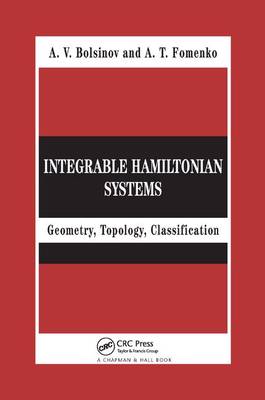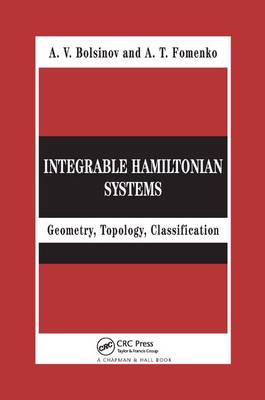
Je cadeautjes zeker op tijd in huis hebben voor de feestdagen? Kom langs in onze winkels en vind het perfecte geschenk!
- Afhalen na 1 uur in een winkel met voorraad
- Gratis thuislevering in België vanaf € 30
- Ruim aanbod met 7 miljoen producten
Je cadeautjes zeker op tijd in huis hebben voor de feestdagen? Kom langs in onze winkels en vind het perfecte geschenk!
- Afhalen na 1 uur in een winkel met voorraad
- Gratis thuislevering in België vanaf € 30
- Ruim aanbod met 7 miljoen producten
Zoeken
Integrable Hamiltonian Systems
Geometry, Topology, Classification
A V Bolsinov, A T Fomenko
Paperback | Engels
€ 129,95
+ 259 punten
Uitvoering
Omschrijving
Integrable Hamiltonian systems have been of growing interest over the past 30 years and represent one of the most intriguing and mysterious classes of dynamical systems. This book explores the topology of integrable systems and the general theory underlying their qualitative properties, singularites, and topological invariants. The authors, both of whom have contributed significantly to the field, develop the classification theory for integrable systems with two degrees of freedom. This theory allows one to distinguish such systems up to two natural equivalence relations: the equivalence of the associated foliation into Liouville tori and the usual orbital equaivalence. The authors show that in both cases, one can find complete sets of invariants that give the solution of the classification problem. The first part of the book systematically presents the general construction of these invariants, including many examples and applications. In the second part, the authors apply the general methods of the classification theory to the classical integrable problems in rigid body dynamics and describe their topological portraits, bifurcations of Liouville tori, and local and global topological invariants. They show how the classification theory helps find hidden isomorphisms between integrable systems and present as an example their proof that two famous systems--the Euler case in rigid body dynamics and the Jacobi problem of geodesics on the ellipsoid--are orbitally equivalent. Integrable Hamiltonian Systems: Geometry, Topology, Classification offers a unique opportunity to explore important, previously unpublished results and acquire generally applicable techniques and tools that enable you to work with a broad class of integrable systems.
Specificaties
Betrokkenen
- Auteur(s):
- Uitgeverij:
Inhoud
- Aantal bladzijden:
- 748
- Taal:
- Engels
Eigenschappen
- Productcode (EAN):
- 9780367394509
- Verschijningsdatum:
- 23/10/2019
- Uitvoering:
- Paperback
- Formaat:
- Trade paperback (VS)
- Afmetingen:
- 155 mm x 234 mm
- Gewicht:
- 1065 g

Alleen bij Standaard Boekhandel
+ 259 punten op je klantenkaart van Standaard Boekhandel
Beoordelingen
We publiceren alleen reviews die voldoen aan de voorwaarden voor reviews. Bekijk onze voorwaarden voor reviews.









